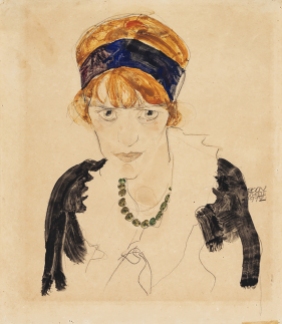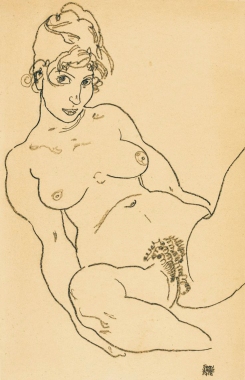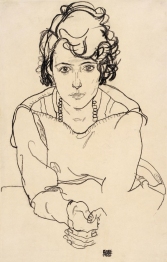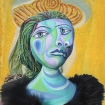Egon Schiele was one of my early art heroes. His stark, fluent line drawings inspired me and still do. I knew nothing of his model and lover Wally Neuzil until more recently, discovering a strong and determined young woman who was crucial in Schiele’s artistic development and his success.

Above: A selection of photos showing sketches and reference, the painted head of Wally and the completed muse sitting on the bench with me .
Wally Neuzil
Walburga Neuzil, known as “Wally” was Egon Schiele’s primary model and muse between 1911-1915. The two met in early 1911 when Wally was only 17 years old and working in the studio of Gustave Klimt. Egon Schiele was a keen admirer of Klimt’s work and looked up to him as his mentor. In return Klimt recognised Schiele’s talent and was very supportive.
The young Wally would not have known then that she would soon become an important part of Egon Schiele’s life and his art.

Wally
Walburga Neuzil was born in 1894 to Thekla and Josef Neuzil in Tattendorf, a small town south of Vienna, where her father was a school teacher. Wally had four sisters; an older sister, Anna Emilia and three younger sisters: Antonia, Maria and Berta, all born two years in succession, meaning Josef and Thekla Neuzil had to work very hard to give their girls a stable, if modest upbringing.
By September 1901 Josef Neuzil had been promoted to head master of the elementary school in the village of Sparbach. His new status was tragically short, he died in February 1902 of an unknown cause at the Mödling hospital, he was only 39.

Vienna
His grieving wife Thekla Neuzil and her five daughters moved to Vienna, where there would be more likelihood of employment. The distress of losing her husband and the cold winter weakened Frau Neuzil’s health, making it a difficult start for the Neuzil girls, who had lost their father and were living in a poor suburb of the city with their sick mother.
From a relatively secure life, their living conditions became precarious, with the family constantly moving from one district to another. Ordinary people and members of the lower classes lived in small apartments, often sharing with boarders or lodgers and were mostly very poor. Thankfully Thekla received a small pension as an official’s widow, which would last until her death, but was not enough to feed her family, so the older girls were expected to find work.

Employment opportunities in early 1900s Vienna for poor or uneducated women were limited to low paid hard work, such as factory jobs, Chambermaids, washerwomen and cleaners. For women who had a basic education there were a few more options open to them in Vienna’s newly opening retail establishments.
At that time the capital of the Austrian-Hungarian Empire was facing radical changes. A building boom meant people came in from all around the realm to search for a better life in Vienna. There was a surge of new political ideas and creativity. The old Habsburg Empire was crumbling, the conservatism of old was being replaced by a modern, libertine abandon. Tensions between past social conventions and emerging contemporary views made the divide between the classes even more visible.
The Artist’s Model
In the early twentieth century an artist’s model was regarded as being no more than a prostitute. It is quite probable that a few models were doubling their trade by working at night, as well as in the studio by day. Egon certainly was in the habit of hiring prostitutes and girls from the park as models.
Wally was coerced into modelling while only a teenager, to help her frail mother feed and clothe her younger sisters. Gustave Klimt had become famous in Vienna and it is thought that Wally was encouraged by her mother to go to Klimt’s studio to ask for modelling work. Instead she became his studio assistant and cleaner because Klimt didn’t use under-aged models at the time.
Egon Schiele
Egon Schiele was a regular visitor to Klimt’s studio and it wasn’t long before he noticed Wally. A year later she happily agreed to model for Schiele, knowing that he was a young up and coming artist, a new talent who was highly thought of by Gustave Klimt and in Wally’s eyes he was very handsome.

By 1911 Wally was not only modelling for Egon Schiele, she became his live in lover, house keeper and delivery girl, who managed all his administrative duties and business affairs, ran errands and paid the rent.
Egon Schiele was a lucky man. Wally was dedicated to him as well as his art and was a bold, adventurous and tireless model. She remained his girlfriend and loyal companion throughout their four year relationship.

Wally was pivotal to some of the brave and experimental new art works made by Schiele; her tawny red hair, bold blue eyes and lavish mouth, combined with her sensual openness, inspired Schiele to explore the female nude in an innovative and explicit new way. He created a series of drawings and paintings that had a unique freedom of line and a dynamic rawness, that both shocked and fascinated the people of Vienna and his contemporaries.
It is said by some art critics that Schiele produced some of his best work while he was with Wally.
During her time in Vienna while modelling for Schiele, Wally additionally worked in a clothes store as a sales assistant and dress model, so she could continue to support her mother and sisters. Once cohabiting with Schiele she was no longer paid for her modelling, despite the fact that her work load included a lot more.
She was happily and wildly in love with Schiele and extremely loyal to him, though he didn’t always deserve her unwavering devotion.
Eventually their affair became well known and talked about, the righteous and bourgeois people of Vienna thought it disgraceful. Schiele started to find the city oppressive and decided in the spring of 1911 to go away to the small Bohemian town of Krumau, taking Wally with him.
Krumau

It was not long however before their open cohabitation and non-conformist behaviour provoked criticism from the conservative townspeople of Krumau. Not only were they furious about what in their view, was an unorthodox lifestyle and sinful relationship, but also with Schiele’s eccentric activities, which included drawing Wally and other models naked in the garden.
This attracted the curiosity of the town’s youth and Schiele became inappropriately friendly with the local teenage girls, aiming to entice them to undress and model for him. The furore that followed forced the pair to move, so their stay in Krumau was short lived.

Neulengbach
After leaving Krumau, Schiele rented a house in the city of Neulengbach, west of Vienna and Wally joined him in August 1911. Life resumed in a way that was no different to before; Wally took on the responsibility of running his business affairs, delivering paintings to Schiele’s now many clients, while he painted and searched for new models.
His unrestrained fascination with the female form meant Schiele had an appetite for variety. It is noted in one of his sketchbooks that he’d had 180 female ‘visitors’ to his studio in a period of only eight months.
Wally accepted his need for inspiration and sometimes posed together with other models, to enable Schiele’s artistic vision and also, to keep an eye on his playful advances towards them. Of course Wally was not happy about his flirtations with these women.



Schiele’s ‘Self Portrait with Physalis’ was painted to be paired with ‘Portrait of Wally Neuzil’
It appeared that children liked Schiele with his childlike manner and clowning ways, as a result the studio soon became an attraction, an after school hang-out. It was a friendly environment and Wally was often there to keep a watch on things while doing her domestic duties, but the local residents were becoming aware of the comings and goings at the artist’s home.

In April 1912 Schiele was dragged in front of the authorities, accused of seducing the runaway daughter of a naval officer who had been seen with her friends loitering at his studio. Schiele was arrested for kidnapping, rape and public immorality; however the first two charges were dropped for lack of evidence. Schiele was sentenced for negligent custody of erotic material, and allegedly exposing minors to sexually explicit drawings in his studio. He spent 24 days in jail.
Schiele’s tendency to befriend and invite children into his studio to pose for him, contributed to his predicament. However, surviving drawings that were made in Neulengbach show that his underaged models were usually clothed.

Trouble started when a girl named Tatjana von Mossig ran away from home and sought refuge with Schiele and Wally. Not really knowing how to deal with the situation, they invited her in and agreed to take her to her grandmother in Vienna the next morning.
When they arrived in the city Tatjana had changed her mind and becoming frightened, she asked to return back home. She was missing for three nights, yet by the time her father came to get her, he had already filed charges of kidnapping and rape against Schiele.
Egon in Jail
During his time in jail, Wally loyally stood by him, trusting in his integrity and providing active support. She brought him food and art materials so he could continue with his work. He made several watercolours and drawings in his cell, mainly anguished self portraits.

Schiele had time to contemplate his future while alone in jail. Gradually he realised that compliance with the demands of society and its’ principles, had to be adhered to if he wanted a successful artistic career. Almost immediately upon his release he made noticeable concessions to conventional morality and he virtually stopped drawing children, focusing on adult models and portraiture.
Wally, who had remained close and supportive of Schiele throughout his crisis, was now seen as an unsuitable companion. Despite all his bohemian affectations, Schiele bowed to pressure and accepted that his model and former mistress would not make him a suitable wife.

The end of the Affair
Schiele was simply the son of a humble stationmaster, but now with his artistic success and grander ambitions he expected more. He wanted to incorporate his artistic exploration and scrutiny of hidden sexuality, within the bourgeois comforts of respectable domesticity. Schiele needed a bourgeois wife.
Back in Vienna, Schiele didn’t look far or waste any time. From his studio window he had noticed his pretty neighbours, sisters Adele and Edith Harms. He soon began courting the younger sister Edith, daughter of the bourgeois ‘Harms’ family who lived opposite. Schiele pleaded with Wally to act as chaperone as Edith’s parents would not have allowed her out with a man unaccompanied. Due to her generous nature Wally obliged.
Edith’s parents were intensely opposed to the artist on account of his famously scandalous lifestyle, but following the outbreak of war in 1914, uncertainties undulated through the city, hastening events along. In 1915 they became engaged and in June that year, Egon Schiele married Edith Harms, shortly before joining the Austrian Army.
The last meeting Wally had with Schiele took place at their local café, the ‘Eichberger’ and it didn’t work out well. It seemed Schiele was reluctant to break all ties with Wally and suggested an unlikely compromise. He handed Wally a legal document that suggested they agree to share a holiday every summer, without his wife Edith.
Wally declined his demeaning and humiliating offer and coolly departed, the two never saw each other again.

Wally retained her dignity despite the hurt she felt and decided to return to active society. She trained to be a nurse in Vienna and worked in a war hospital there, before joining the Red Cross in Dalmatia, now part of Croatia.
In 1917, just before Christmas Wally Neuzil died of scarlet fever in a military hospital aged only 23.
In 1918 the Spanish flu spread across Austria like wildfire. Local newspapers reported two thousand two hundred deaths per week.
At six months pregnant Edith died of the disease and Schiele followed her three days later, aged 28.


OTHER 20TH CENTURY MUSES BY MARINA
LYDIA DELECTORSKAYA MATISSE’ MUSE
MARIE-THÉRÈSE WALTER PICASSO’S MUSE
DORA MAAR SURREALIST
EMILIE FLÖGE KLIMT’S MUSE
FRIDA KAHLO MUSE
TEHA-AMANA GAUGUIN’S MUSE
Acknowledgements and further Reading
Ian Buruma New York Review of Books
Leopold museum
Kerry Postle: The Artist’s Muse
https://wallyneuzilenglish.weebly.com/about-wally-neuzil.html
http://www.bbc.com/culture/story/20150227-artists-muse-a-secret-life
Your comments are always welcome

















































A satisfying visual and informative experience. AND a helluva original idea for incorporating your work into the researched content. Impressive
LikeLiked by 1 person
Thank you so much, I am happy you appreciate my work and research 👍
LikeLike
Wally’s story is fascinating and sad. I’m glad I found this special place you created. Your Wally is a beautiful.
LikeLike
Thank you Christina, it was a sad ending for Wally especially, but her determination and generous spirit helped her through the highs and lows of her relationship with Egon; as well the final betrayal.
I am glad you like my site ☺️
LikeLike
I love this! I found Wally’s story inspirational, that’s why I wrote The Artist’s Muse. Your work is beautiful Marina. I only wish I had a Wally too. Would have chosen her as cover for my novel https://www.amazon.co.uk/Artists-Muse-Kerry-Postle-ebook/dp/B06Y5175Z5
LikeLiked by 1 person
Thank you Kerry, that means a lot to me coming from you.
I loved your book “The Artist’s Muse”, it brought Wally as a woman to life and helped me visualise and create her.
LikeLike
Marina, you have succeeded again to make an artist muse come to life with fascinating insight of the model and muse.
An unusual choice to present Egon Schiele with Wally Neuzil, his young model.
I found some of the detail of your muse in her underwear rather amusing showing her in compromising positions.
I admire your hard work and tenacity in pursuing new creative ideas for this wonderful collection of muses. I do so hope that you will get the publicity and recognition that you deserve.
LikeLiked by 1 person
AMAZING!! What a sad ending tho!
We are hoping to go to Vienna…chemo allowing…and I will enjoy seeing lots of Schiele works…and to know more about him and Wally is such a bonus!!
Thank you Marina
Love Jane xxx
LikeLiked by 1 person